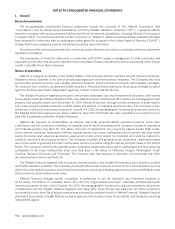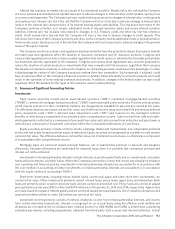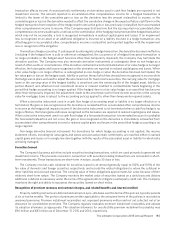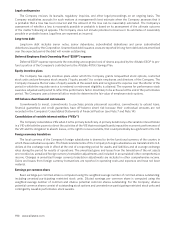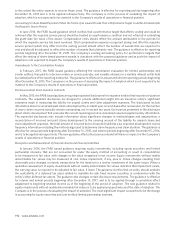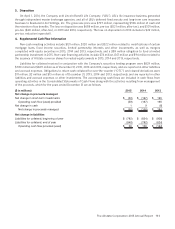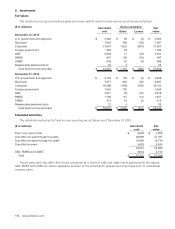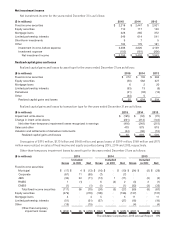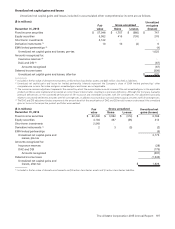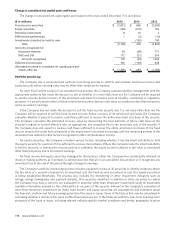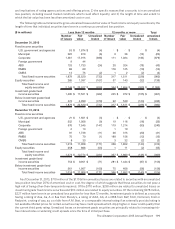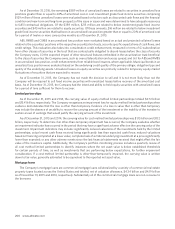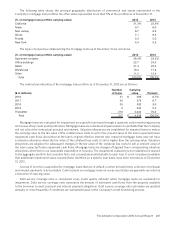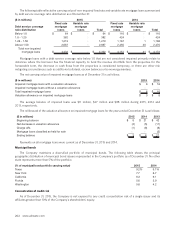Allstate 2015 Annual Report Download - page 198
Download and view the complete annual report
Please find page 198 of the 2015 Allstate annual report below. You can navigate through the pages in the report by either clicking on the pages listed below, or by using the keyword search tool below to find specific information within the annual report.192 www.allstate.com
to the extent the entity expects to recover those costs. The guidance is effective for reporting periods beginning after
December 15, 2017 and is to be applied retrospectively. The Company is in the process of evaluating the impact of
adoption, which is not expected to be material to the Company’s results of operations or financial position.
Accounting for Share-Based Payments When the Terms of an Award Provide That a Performance Target Could Be Achieved after
the Requisite Service Period
In June 2014, the FASB issued guidance which clarifies that a performance target that affects vesting and could be
achieved after the requisite service period should be treated as a performance condition and not reflected in estimating
the grant-date fair value of the award. Compensation costs should reflect the amount attributable to the periods for
which the requisite service has been rendered. Total compensation expense recognized during and after the requisite
service period (which may differ from the vesting period) should reflect the number of awards that are expected to
vest and should be adjusted to reflect the number of awards that ultimately vest. The guidance is effective for reporting
periods beginning after December 15, 2015. The Company’s existing accounting policy for performance targets that
affect the vesting of share-based payment awards is consistent with the proposed guidance and as such the impact of
adoption is not expected to impact the Company’s results of operations or financial position.
Amendments to the Consolidation Analysis
In February 2015, the FASB issued guidance affecting the consolidation evaluation for limited partnerships and
similar entities, fees paid to a decision maker or service provider, and variable interests in a variable interest entity held
by related parties of the reporting enterprise. The guidance is effective for annual and interim reporting periods beginning
after December 15, 2015. The Company is in the process of assessing the impact of adoption which is not expected to be
material to the Company’s results of operations or financial position.
Disclosures about Short-Duration Contracts
In May 2015, the FASB issued guidance requiring expanded disclosures for insurance entities that issue short-duration
contracts. The expanded disclosures are designed to provide additional insight into an insurance entity’s significant
estimates made in measuring the liability for unpaid claims and claim adjustment expenses. The disclosures include
information about incurred and paid claims development by accident year, on a net basis after reinsurance, for the number
of years claims incurred typically remain outstanding, not to exceed ten years. Each period presented in the disclosure
about claims development that precedes the current reporting period is considered required supplementary information.
The expanded disclosures also include information about significant changes in methodologies and assumptions, a
reconciliation of incurred and paid claims development to the carrying amount of the liability for unpaid claims and
claim adjustment expenses, the total amount of incurred but not reported liabilities plus expected development, claims
frequency information including the methodology used to determine claim frequency and claim duration. The guidance is
effective for annual periods beginning after December 15, 2015, and interim periods beginning after December 15, 2016,
and is to be applied retrospectively. The new guidance affects disclosures only and will have no impact on the Company’s
results of operations or financial position.
Recognition and Measurement of Financial Assets and Financial Liabilities
In January 2016, the FASB issued guidance requiring equity investments, including equity securities and limited
partnership interests, that are not accounted for under the equity method of accounting or result in consolidation
to be measured at fair value with changes in fair value recognized in net income. Equity investments without readily
determinable fair values may be measured at cost minus impairment, if any, plus or minus changes resulting from
observable price changes in orderly transactions for the identical or a similar investment of the same issuer. When a
qualitative assessment of equity investments without readily determinable fair values indicates that impairment exists,
the carrying value is required to be adjusted to fair value, if lower. The guidance clarifies that an entity should evaluate
the realizability of a deferred tax asset related to available-for-sale fixed income securities in combination with the
entity’s other deferred tax assets. The guidance also changes certain disclosure requirements. The guidance is effective
for interim and annual periods beginning after December 15, 2017, and is to be applied through a cumulative-effect
adjustment to beginning retained income as of the beginning of the period of adoption. The new guidance related to
equity investments without readily determinable fair values is to be applied prospectively as of the date of adoption. The
Company is in the process of evaluating the impact of adoption. The most significant impact is expected to be the change
in accounting for equity securities and cost method limited partnership interests.


